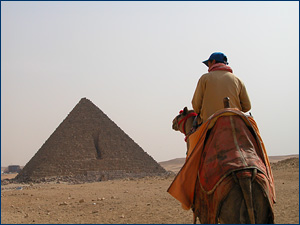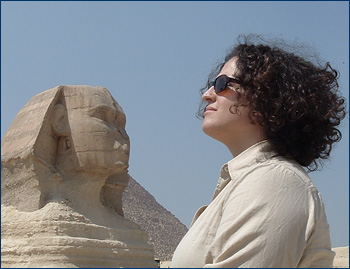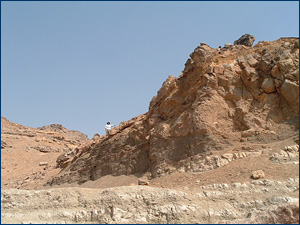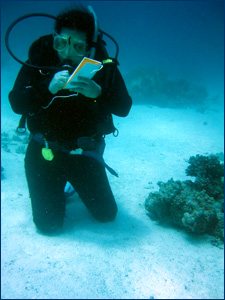
A Bedouin tout selling camel rides in front of the "Small" pyramid, Giza, Egypt.
Pyramids, forams, and Red Sea reefs: Field notes from Lorraine Casazza
By UCMP grad student Lorraine Casazza, October 27, 2007
| Lorraine came to Egypt on a Fulbright Fellowship to work on a coral reef monitoring method using foraminifera, and has been granted a six-month extension to continue her work. Lorraine believes that the decline of coral reefs is a global problem that requires global solutions. Through international collaboration, scientists have the ability to bring cultures, and nations, together. |
October 27, 2007
 A Bedouin tout selling camel rides in front of the "Small" pyramid, Giza, Egypt. |
"Don't look! Just keep walking," I whisper to my sister, but I'm fighting against a lifetime of good manners. Instinctively she turns to smile, and I can see the gleam of the Bedouin's grin from the corner of my eye.
We've been hooked — again!
He nudges his camel closer and closer until my sister is trying not to visibly cower. Camels are handsome animals, but they're also tall — taller than a horse, and that can be intimidating up close.
Of course the Bedouin tout knows that, and he uses it to his advantage.
"Don't be frightened — you want camel ride? You know how much for camel ride?"
"Twenty pounds," I say in Egyptian Arabic, trying to simultaneously extract us from the exchange, but also not seem too unfriendly. It's a tricky interaction, and one that we will repeat dozens of times before the day is over. Along with unsightly litter and tacky souvenirs like dancing camel dolls and plastic Cleopatra heads, aggressive touts are one of the unavoidable irritations of visiting the oldest, most famous tourist destination on Earth.
This is my fourth trip out to the pyramids of Giza, one of which is the Great Pyramid, also known as the Pyramid of Cheops. This is the only wonder of the original Seven Wonders of the World that's still standing, and even on the fourth visit it still inspires a sense of wonder. I'm suitably impressed by the ingenuity and skill that went into constructing a 480 foot monument made of blocks that weigh about 2.5 tons each, accomplished more than 4500 years ago, millennia before the advent of forklifts and cranes. However, this isn't what really gets me fired up about the pyramids. The thrilling part for me is what they're made of.
 Lorraine doing her best Sphinx imitation, Giza, Egypt. |
In fact, the Nummulites in the pyramids are a lot older than that. They lived during the Eocene, which is the name we give to the period of time starting about 56 million years ago and ending 34 million years ago. During this time most of northern Africa, including Egypt, as well as southern Europe, was covered by an ocean we now call the Tethys ocean. Nummulites, (along with a lot of other creatures) lived on the bottom of the shallow areas of this ocean. Over millions of years, their shells piled up, creating the rocks that were quarried to build the pyramids.
That's pretty impressive, but there's a lot more to Nummulites than their potential to make good bricks!
They may not look as intimidating as, say, a T. rex, but Nummulites are giants in their own right. Nummulites and some of their relatives are the biggest single-celled organisms to ever exist in the history of life. Imagine an amoeba 10 centimeters (or about 4 inches) across, and you're pretty close. Most cells are really small because things move in and out of a cell by diffusion across the cell membrane, and the more volume there is to the cell, the more surface area there needs to be to make sure that diffusion to all parts of the cell can happen quickly enough to keep the cell alive. This relationship between volume and surface area places a powerful limitation on how big any cell can get.
Nummulites and other large foraminifera get around this problem by making sure there's a whole lot of surface area relative to volume, and they do this by having very complex shells. They may look like lentils or coins on the outside, but on the inside there is a complex arrangement of chambers, connected by small pores through which the cell cytoplasm can move. Conforming to the shape of all these small "rooms" ensures that there is plenty of surface area for the large cell volume. These highly organized shells also allow the single cell to be compartmentalized. In other words, different activities occur in different areas of the cell — for example, food digestion is concentrated in the peripheral chambers. It's a pretty amazing solution to a mechanical limitation faced by all life.
Why so big?
One aspect of my research in Egypt focuses on why these foraminifera got so huge. Nummulites are some of the most dramatic examples of gigantism in this group, but they aren't the only example, which implies that there's an evolutionary advantage to getting so big. The most widely accepted explanation is that big shells are actually a by-product of having algae living inside of the foraminifera, in other words, having algal symbionts. Because these algae perform photosynthesis, they alter the cell chemistry in a way that makes it possible for the cell to secrete shell material much faster than it could without the algal symbionts. In this scenario, getting big per se isn't advantageous. Having symbionts is, and getting big is a result of having symbionts.
 Lorraine standing on late Eocene rocks of the Moqqatam Formation on the other side of the Nile Valley from the Giza Pyramids, searching for the last of the Eocene Nummulites. |
But it's not as easy as it sounds! For the lab tests to work, I have to use original shell material, and it's pretty tough to find anything that hasn't changed in 45 million years. I'll be searching Egypt for outcrops that have unusually good preservation of nummulite shells with plenty of help from my Egyptian colleagues, Dr. Strougo and Dr. Boukhary of Ain Shams University.
This is a question that really fascinates me, because it's a very specific test of a much more general question, which is: what role has symbiosis played in the evolution of life? It's often the case in science that we have big questions about how the world works, but the only way to get at them is through a lot of small, specific questions that eventually, may add up.
In recent decades, scientists working in molecular and cell biology have performed countless specific tests exploring the relationships between various host organisms and their symbionts. Added all together, that research is beginning to reveal some astounding things about how symbiotic relationships develop, and how those relationships can affect the genetic future of the organisms involved. Ultimately, I'd like to explore what kind of information the fossil record can provide on these subjects, and Nummulites provide a great starting point.
Assessing reef health in the Red Sea
But Egypt provides so many extraordinary natural environments, that it's almost impossible, for me at least, to limit my research to one area. In fact, the project I moved here to work on begins about 500 km (310 miles) away from the pyramids in Hurghada, a big resort town on the Red Sea. Millions of tourists visit Hurghada and other resort towns on the Egyptian Red Sea to snorkel and dive some of the most amazing coral reefs on earth. That kind of tourism can really take a toll on reef ecosystems, and in a variety of ways.
 Before any samples are collected, Lorraine explores the field site. Reef topography, prevailing currents, and sediment distribution on the reef determine the best way to collect. |
For another thing, all those people coming to visit dive sites can cause a lot of mechanical damage. Even if only a tiny percentage of those millions of visitors accidentally kick a branch of coral, or decide to snap off just a small piece for a souvenir, that really adds up over time. Plus, when that many visitors are in the water every day, it scares the fish off — permanently. Hundreds of dive boats carrying those visitors have to anchor somewhere, which until recently, was on the reefs themselves, and their bathrooms empty directly into the water.
The Egyptian Environmental Affairs Agency works hard to protect the local reefs while still allowing the tourist trade, which is such a vital part of Egypt's economy, to flourish. I'm hoping to make their job a little easier by adapting a simple, inexpensive reef monitoring method to the Red Sea environment.
Pam Hallock, a scientist studying foraminifera in the Florida Keys, developed a method using assemblages of modern foraminifera (not fossil Nummulites!) to assess if local water conditions are appropriate for good coral health. There are some pretty big differences between the Caribbean reefs of the Florida Keys, and the reefs of the Red Sea, but I think this method will be robust enough to be adapted to a new reef ecosystem. It may also provide a way to distinguish reef decline due to mechanical damage caused by visiting divers, or reef decline due to water quality issues generally related to coastal development.
This will first require using SCUBA diving to collect sediment from various depths on coral reefs. After that, I get to spend many, many hours looking at sand under a microscope and using a very slender paintbrush to "pick" the foraminifera out of the sand. After that I'll have to identify and count them, and assign each species to an "ecological type" according to what kinds of environments they thrive in.
And since I'm convinced that fossils can provide relevant information to almost any biological question, I'll be collecting fossil reef foraminifera from the Pleistocene-aged (the period from about 1.8 million years ago to about 12,000 years ago) reefs that outcrop all along the shoreline of the Red Sea. I'll try to apply the same monitoring method to these fossil assemblages in order to provide a baseline of reef health that predates all human impact.
Comparing Pleistocene reefs to living reefs
It was while I was trying to figure out how to even locate (let alone sample) foraminifera from the fossil reefs that I began to wonder about the reefs themselves. There are four fossil reef "terraces" that lived during the last interglacial period, when sea levels were high. There was a hiatus in reef growth after that, when glaciers expanded in response to a cooler global climate, locking up the Earth's water in ice and causing sea levels to drop. Other researchers looking at fossil reefs in Papua New Guinea concluded that during this hiatus, reefs around PNG simply migrated with the dropping sea level during that hiatus. This is why the fossil reef organisms are so similar to the ones still living on modern reefs.
But would we expect the same thing here? When sea level dropped in the Red Sea, it was totally cut off from its only contact with the other world's oceans — a very shallow ledge called the Bab al Mandeb, which opens to the Indian Ocean, may have become a dry land bridge. Once that connection was cut off, would the Red Sea have become hypersaline, eliminating the possibility of reef survival? Or would the increased fresh water run off from land during that time have been enough to keep salinities in a normal range for coral growth? If the reefs died off here during the last interglacial and the Red Sea had to be recolonized from the Indian Ocean, could we still expect the same general species make-up before and after this dramatic environmental event?
Incredibly, little work has been done on these fascinating fossil outcrops. It's exciting and overwhelming to try and characterize them in order to compare the Pleistocene reef communities to the living reefs, but I've been able to get some other scientists involved. Dr. Strougo will take on the identification of the bivalves and echinoids, and with a little luck I'll be able to convince Dr. Moshira Hassan of the American University in Cairo and her husband to work out the corals. I'm still looking for a gastropod taxonomist — so if you know any experts in Pleistocene marine snails, let me know!
Photos of two species of Nummulites, closeup of pyramid block, equatorial section of Nummulites, closeup of coral by Lorraine Casazza; tout, quarry, limestone (with foot), Lorraine and Michele, and coral in original position by Jere Lipps; Great Pyramid by Bart Rolfson; Lorraine with the Sphinx and Lorraine standing on the Moqqatam Formation by Timothy Pearson; Lorraine underwater by Scott Fay.